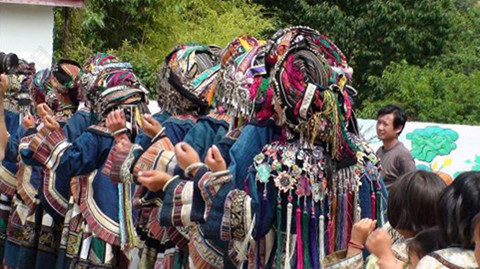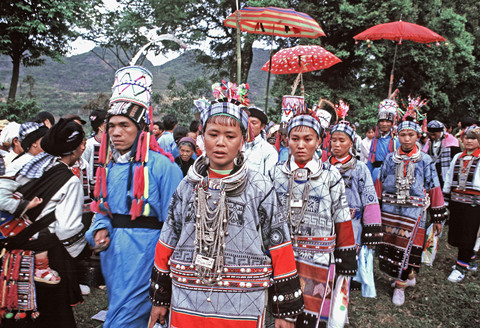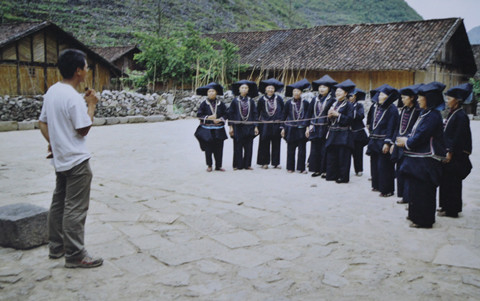
Overland ethnic culture tour to Southeast Yunnan
This article is jointly shared by Robert, an expatriate and long-time resident in Kunming, and Adam Yang.

The Bo people, Qiubei County
The somewhat underdeveloped southeast of Yunnan Province mainly includes Wenshan Miao and Zhuang Autonomous Prefecture, and part of Honghe Hani and Yi Autonomous Prefecture. There are very famous tourist spots such as the Bamei Zhuang Ethnic Village in Guangnan County, and Puzhehei Resort of Qiubei County which is a paradise for water fights in summertime. But bound for this part of Yunnan, how can you evade throngs of tourists and what can you do in particular? An ethnic cultural tour-if you are a fan of ethnic groups of Yunnan.
The tour starts from Kunming, the capital city of Yunnan, and you can choose to visit the counties of Qiubei, Guangnan, Yanshan, Funing, and finally reach Guangxi's Napo County on the border between China and Vietnam.
Qiubei County
There are several branches of Yi ethnic groups living in this Karst-landform county. Besides the Sani people in Puzhehei Resort, whose costumes differ from those who live near the Stone Forest of Kunming, you can go to visit Bainitang (Shede Town), Liuwanpo (Shuanglongying Town), and Muzhutang (Shuanglongying Town) villages where you'll marvel at the dazzling costumes of the Bo people, and the stony, rugged terrain.
Many farmers in Qiubei plant acres of chilis, so this county is dubbed “the hometown of chilis”. Indeed, you can see chains of chilis being dried on house walls, shelves and special makeshift buildings, as you travel through the countryside. In China, Hunan and Sichuan provinces are widely known for the chili that is widely used in the Chuan Cuisine and Xiang Cuisine; but Qiubei of Yunnan can rival the two as far as chilis are concerned.

Chili is a famous specialty of Qiubei County
In Liuwanpo Village, you can go around to see how villagers live; all the walls are made from lime stone, and most of the farmland suitable for growing corn. The village is 16 km from Shuanglongying Town, but the journey there involves is hard ride due to the rough, bumpy, stony road.
Travel route: Qiubei county seat-40km-Shuanglongying-16km-YezhutangVillage or Liuwanpo Village;
Funing County
The Yi ethnic minority in Funing County can be divided into such branches as the Baiyi (White Yi), Heiyi (Black Yi), Hualuoyi, Baihua Yi and Gakujiao Yi etc.

The Hualuo branch of the Yi ethnic minority, Funing County
The townships of Banlun, Muyang and Tianpeng are the best places to meet some of the Yi ethnic branches.
Muxiangcun Village, of Muyang Township, is on the asphalted roadside. You can drop in on a family and take photos of the Hualuo branch of the Yi people. Another place for the Luo branch is Mie’non Village of Tianpeng Township; cars can go directly to the village.

The Tiaogong Festival, Longmai Village, Banlun Town
During each lunar April to June, the Yi people of Banlun Township celebrate a traditional festival locally called "Tiaogong Festival".
The festival is mainly dedicated to the ancestor-worship of the Yi people, who are said to migrate from the north due to persecution by governments in ancient times. It's said that the ancestors of the Yi won after years of struggle against the government, and the commemorations to honor the triumph have over time evolved into what is now the "Tiaogong Festival". On festival days, all the ethnic Yi from nearby villages dress in their traditional costumes to join the three-day (annually) or nine-day (decadally) event.
Napo County
Napo County of Guangxi Zhuang Autonomous Region is adjacent to Vietnam and is a neighbor of Funing County of Yunnan Province. It is home to as many as 12 branches of the Zhuang ethnic minority, among whom the Black Zhuang is best-known for their distinctive culture. Napo's Black Zhuang make up about 33% of the Zhuang ethnic population; and Tunlitun Village is the most primitive destination to visit for an insight into their life style.

The Black Zhuang ethnic members, Napo County
Tunlitun is the closest destination to the county seat, only 14 km away. Going there for the first time, you will find this village is actually hidden among Karst hills, and most of the buildings are built with natural lime stones, similar to Nuohei Village near the Stone Forest. As a branch of the Zhuang ethnic minority, the Black Zhuang here treat guests with great hospitality; whilst entering the arched gate, you will be served wines/rice wine while the Black Zhuang members singing folk songs in their language which you won’t understand. You will also be invited to play a game called "whispering by a wired phone" which is composed of two bamboo tubes connected by a thread.

Exploring Napo, you can go furt



